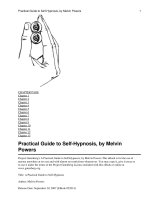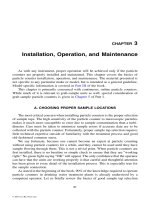Echocardiography A Practical Guide to Reporting - part 3 pps
Bạn đang xem bản rút gọn của tài liệu. Xem và tải ngay bản đầy đủ của tài liệu tại đây (365.05 KB, 16 trang )
ch02 4/5/07 1:32 pm Page 22
3
MYOCARDIAL
INFARCTION
1. Regional LV systolic function
The diagnosis is confirmed in the appropriate clinical context by a regional
wall motion abnormality.
• Describe the segments affected.
• Are the segments thin? This implies a non-viable scar, while a thick-
ness >6 mm suggests that there might be viable myocardium.
• Comment on the other regions. Compensatory hyperkinesis is a good
prognostic sign. Hypokinesis of a territory other than of the acute
infarct suggests multivessel disease and is a poor prognostic sign.
2. Global systolic function
• The ejection fraction and velocity integral should be described. Both
give prognostic information.
• If the ejection fraction appears to be low by eye, then measure the
systolic and diastolic volumes using Simpson’s rule. The systolic
volume refines risk, and the ejection fraction is used to guide the
decision for implantable defibrillator or resynchronisation.
3. Right ventricle
• Up to 30% of all inferior infarcts are associated with RV infarction,
and in 10% the RV involvement is significant.
• Estimate PA pressure.
4. Describe the mitral valve
• Mitral regurgitation is common after infarction (Table 3.1).
• A restricted posterior leaflet causing a posteriorly directed jet is
common after an inferior or posterior infarction.
• ‘Tenting’ of both leaflets leading to a central jet occurs when there is
dilatation of the mid and apical parts of the LV cavity.
ch03 4/5/07 1:33 pm Page 23
Echocardiography: A Practical Guide for Reporting
24
Table 3.1 Causes of mitral regurgitation after myocardial infarction
• Restricted posterior mitral leaflet (page 52)
• LV dilatation leading to ‘tenting’ of the mitral leaflets
• Rupture of papillary muscle or major chordae
• Mitral prolapse after minor chordal dysfunction (rare)
• Coexistent mitral valve disease
Table 3.2 Complications after myocardial infarction
• Thrombus (Table 3.3)
• Aneurysm (Figure 3.1)
• Pseudoaneurysm (Figure 3.1)
• Papillary muscle rupture
• Ventricular septal rupture
Table 3.3 Features of thrombus
• Underlying wall motion abnormality
• Cleavage plane between thrombus and LV wall
• Higher density than myocardium
5. Complications (Table 3.2)
• If there is a murmur, then check for mitral regurgitation and ventric-
ular septal rupture. These may coexist. If there is mitral regurgitation,
then consider the causes listed in Table 3.1.
• Complete or partial rupture of the papillary muscle or septal rupture
should be reported directly to the responsible clinician.
• A true aneurysm complicates about 5% of all anterior infarcts and is
an indicator of a poor prognosis. It must be distinguished from a false
aneurysm caused by free wall rupture contained by the pericardium
(Table 3.4 and Figure 3.1).
ch03 4/5/07 1:33 pm Page 24
Myocardial infarction
25
Figure 3.1
True and pseudoaneurysm. (a) A true aneurysm is caused by the infarct bulging
outwards so that there is a wide neck and the myocardium is often seen in the
border zone of the aneurysm. (b) A pseudoaneurysm is a rupture of the infarcted
myocardial wall with blood being contained by the pericardium so that the
pseudoaneurysm contains no myocardial tissue. In this example, there is a large
thrombus within the cavity of the pseudoaneurysm, with a small residual space
outlined by transpulmonary contrast. The inferior myocardial wall is thin and
interrupted by the rupture point, which forms the usually narrow neck through
which blood enters in systole and leaves in diastole
(a)
(b)
ch03 4/5/07 1:33 pm Page 25
Echocardiography: A Practical Guide for Reporting
26
Checklist for reporting myocardial infarction
1. Regional wall motion
2. Global systolic function
3. RV
4. Mitral regurgitation
5. Complications
Table 3.4 Differentiation of true and pseudoaneurysm
True aneurysm Pseudoaneurysm
(Figure 3.1a) (Figure 3.1b)
Position More commonly apical More commonly posterior
Neck Wide Narrow
Boundary Myocardium Pericardium
Colour flow Swirling or absent Into in systole, out in diastole
ch03 4/5/07 1:33 pm Page 26
4
CARDIOMYOPATHIES
DILATED LV
Secondary myocardial impairment (e.g., as a result of hypertension) cannot
be reliably differentiated from the primary cardiomyopathies on echocar-
diography.
1. Diagnosis using cavity dimensions and systolic function
• Some normal ranges in use are too narrow and may result in overdiag-
nosis of LV dilatation, especially in large subjects. Diastolic diameters
as large as 5.9 cm may be normal (see pages 129–131).
Table 4.1 Causes of a dilated hypokinetic LV
Common
Myocardial infarction
Hypertension
Alcohol
HIV
End-stage aortic valve disease or mitral regurgitation
Ischaemic cardiomyopathy
Uncommon
Myocarditis (e.g. viral, vasculitis)
Peripartum cardiomyopathy
Neuromuscular disorders (e.g. Duchenne’s muscular dystrophy)
Dilated cardiomyopathy
Sarcoid
Haemochromatosis
Cocaine
Non-compaction (Table 4.13)
ch04 4/5/07 1:33 pm Page 27
Echocardiography: A Practical Guide for Reporting
28
Table 4.2 Causes of LV dilatation and hyperkinesis
Valve lesions
• Aortic regurgitation
• Mitral regurgitation
Shunts
• Persistent ductus
• Ventricular septal defect
• Ruptured sinus of Valsalva aneurysm
Table 4.3 Features of athletic heart
1
• LV dilatation: diastolic diameter up to 7 cm in men and 6.6 cm in
women
• Normal systolic function; occasionally borderline global hypokinesis
• Mild LV hypertrophy; septum usually ≤1.3 cm
a
• Normal LV diastolic function
• Mild RV dilatation and hypertrophy
a
Weightlifters and rowers may have septal thickness up to 1.6 cm
Table 4.4 Echocardiographic findings in sarcoid
2
• Regional wall thinning especially at base of heart
• Aneurysmal dilatation
• Occasionally global LV dysfunction
• Localised mass (may involve papillary muscle, causing mitral
regurgitation)
• Pericardial effusion
• Is the LV hypokinetic (Table 4.1), normal, or hyperkinetic (Table
4.2)? Borderline hypokinesis is normal in athletic hearts (Table 4.3).
2. General appearance
• Is there a regional abnormality suggesting an ischaemic aetiology?
(Figure 2.1)
ch04 4/5/07 1:33 pm Page 28
• Is there LV hypertrophy suggesting hypertension?
• Are both ventricles dilated suggesting a cardiomyopathy?
• Is there a valve abnormality as a possible cause of secondary myocar-
dial impairment?
• Are there unusual features? These may include the following:
– regional wall motion abnormality crossing arterial territories (e.g.,
sarcoid) (Table 4.4)
– bright endocardial echoes (haemochromatosis)
– apical echogenicity (consider thrombus, non-compaction)
– abnormal myocardial density (non-specific, but consider amyloid).
3. Quantify systolic function (page 5) and assess diastolic
function (page 11)
4. Are there complications?
These include the following:
• thrombus
• functional mitral regurgitation
• pulmonary hypertension.
HYPERTROPHIED LV
1. Diagnosis and quantification of hypertrophy
• Sometimes, hypertrophy is immediately obvious – e.g. in a patient
with hypertrophic cardiomyopathy (Figure 4.1). Myocardial width
should then be measured at a number of points – typically in anterior,
posterior, lateral and septal segments at the base and at mid-cavity
level.
• More usually, the diagnosis is made after measuring wall thickness
(page 129), supplemented by estimation of mass (page 139). This is
Cardiomyopathies
29
Checklist for reporting LV dilatation
1. LV dimensions, including wall thickness
2. LV systolic and diastolic function
3. RV size and function
4. Pulmonary pressure
5. Valve function
6. Thrombus?
ch04 4/5/07 1:33 pm Page 29
performed in patients with hypertension or large QRS voltages on the
ECG.
• 3D and 2D methods of estimating mass are not yet widely used. An
estimate can be made from linear dimensions at the base of the heart,
using the following approximation:
0.83 × [(LVDD + IVS + PW)
3
– LVDD
3
]
• Mass must then be corrected for body habitus (Appendix 4), and can
be used for grading hypertrophy (Table 4.5).
• Generalised hypertrophy is defined as concentric if the cavity size is
small (Table 4.6).
• Concentric remodelling may develop in pressure overload even if the
LV mass is normal. It is defined by a regional wall thickness (RWT)
>0.45, where
RWT =
ᎏ
2
LV
×
D
P
D
W
ᎏ
• LV mass is not routinely estimated if there is eccentric hypertrophy,
which is defined by a large cavity size and develops in volume-load
(e.g. severe aortic regurgitation).
Echocardiography: A Practical Guide for Reporting
30
Figure 4.1 Apical hypertrophic cardiomyopathy
ch04 4/5/07 1:33 pm Page 30
2. Quantify systolic function and assess diastolic function
• Impaired systolic function with significant hypertrophy suggests
amyloid rather than hypertrophic cardiomyopathy.
• Restrictive rather than slow or pseudonormal filling suggests amyloid.
3. Is there intracavitary or outflow tract flow acceleration?
This is assessed using continuous-wave Doppler from the apex. A peak
velocity ≥2.7 m/s is a threshold for obstructive hypertrophic cardio-
myopathy.
4
4. Other signs
Look for the following:
Cardiomyopathies
31
Table 4.5 Grading LV hypertrophy
3
Borderline Moderate Severe
Women
LV mass (g) 163–186 187–210 ≥211
LV mass/BSA (g/m
2
) 96–108 109–121 ≥122
IVS (cm) 1.0–1.2 1.3–1.5 ≥1.6
Men
LV mass (g) 225–258 259–292 ≥292
LV mass/BSA (g/m
2
) 116–131 132–148 ≥149
IVS (cm) 1.1–1.3 1.4–1.6 ≥1.7
Table 4.6 Causes of concentric hypertrophy
a
Common Uncommon
Hypertension Hypertrophic cardiomyopathy
Aortic stenosis Amyloid
Storage diseases
Friedrich’s ataxia
a
Defined as RWT >0.45.
ch04 4/5/07 1:33 pm Page 31
• systolic anterior motion of the anterior leaflet of the mitral valve or
of the chordae alone
• mitral regurgitation directed posteriorly away from the point of
anterior motion
• abnormally long anterior mitral leaflet
• thickening of the valves
• early closure of the aortic valve.
5. Hypertrophic cardiomyopathy versus hypertension
• The diagnosis of cardiomyopathy is made using all available clinical
data.
• The echocardiography report alone should never make a new diagno-
sis, but can suggest hypertrophic cardiomyopathy (Table 4.7).
Echocardiography: A Practical Guide for Reporting
32
Table 4.8 Athletic heart versus mild hypertrophic cardiomyopathy: features in
favour of cardiomyopathy
5
• Asymmetric hypertrophy
• Involvement of both ventricles
• LV diastolic cavity dimension <45 mm
• Significant LA enlargement
• Diastolic dysfunction
• Female gender or family history of hypertrophic cardiomyopathy
• Abnormal ECG
• No change with detraining
Table 4.7 Hypertrophic cardiomyopathy versus hypertension: features in favour of
hypertrophic cardiomyopathy
• Localised hypertrophy most frequently affecting the septum
• Hypertrophy affecting both ventricles
• Septal hypertrophy >2 cm in a non-Afro-Caribbean subject
• Abnormally long anterior mitral leaflet
• Severe systolic anterior motion of the anterior mitral leaflet
• Severe intracavitary flow acceleration
• Premature closure of the aortic valve
• Large QRS voltages and T-wave changes on the ECG
ch04 4/5/07 1:33 pm Page 32
6. Hypertrophic cardiomyopathy versus athletic heart
• Endurance athleticism usually causes mild septal thickening (≤13 mm)
associated with a dilated LV cavity. Hypertrophic cardiomyopathy is
not usually diagnosed unless the septal width >15 mm.
• There may be confusion if the septal width is 13–15 mm (Table 4.8).
7. Hypertrophic cardiomyopathy versus amyloid
The distinction may sometimes be difficult, but amyloid is favoured by
the following:
• LV hypokinesis
• small complexes on the ECG
• valve thickening.
RESTRICTIVE CARDIOMYOPATHY
In a patient suspected of heart failure with no obvious LV hypertrophy
or dilatation and normal systolic function, consider the cardiac causes in
Table 4.9.
• Look for a restrictive transmitral filling pattern and engorged IVC
suggesting pericardial constriction or restrictive cardiomyopathy.
These are differentiated on page 15.
• Severe bi-atrial enlargement suggests restrictive cardiomyopathy.
Cardiomyopathies
33
Checklist for reporting LV hypertrophy
1. Location of hypertrophy (check RV as well)
2. Wall thickness at representative levels
3. LV systolic and diastolic function
4. Systolic anterior motion?
5. LV outflow acceleration
Table 4.9 Cardiac causes of suspected heart failure with an apparently normal LV
• Restrictive cardiomyopathy
• Constrictive pericarditis
• RV dysfunction (page 89)
• Pulmonary hypertension (page 94)
ch04 4/5/07 1:33 pm Page 33
• Look for features suggesting the cause of restrictive cardiomyopathy,
of which amyloid is the most common (Table 4.10).
Echocardiography: A Practical Guide for Reporting
34
Table 4.10 Restrictive cardiomyopathies
Cause Comment
Secondary – infiltrative
Amyloid See Table 4.11
Sarcoid See Table 4.4
Post-irradiation Valve thickening. Combined constriction
Secondary–storage disease
Haemochromatosis Endocardial echogenicity
Glycogen storage
Fabry’s disease
Primary
Endomyocardial fibrosis See Table 4.12
Loeffler’s endocarditis See Table 4.12
Idiopathic
Table 4.11 Features of amyloid
• Hypertrophy affecting both ventricles
• LV hypokinesis
• Heterogeneous myocardial texture
• Restrictive filling
• Generalised valve thickening
Table 4.12 Features of endomyocardial fibrosis and Loeffler’s endocarditis
• Echogenicity at RV or LV apex
• Subvalvar LV or RV thickening
• Tricuspid or mitral regurgitation
• LV or RV thrombus
ch04 4/5/07 1:33 pm Page 34
ARRHYTHMOGENIC RV DYSPLASIA AND LV NON-
COMPACTION
1. If the LV apex is abnormally thickened
Consider the following:
• thrombus
• apical hypertrophic cardiomyopathy (Figure 4.1)
• endomyocardial fibrosis (Table 4.12)
• non-compaction (Table 4.13 and Figure 4.2).
2. Isolated RV dilatation?
Consider the following:
• RV infarct
• dilated cardiomyopathy confined to the RV
• pulmonary hypertension
• ARVD (Table 4.14 and Figure 10.1).
Cardiomyopathies
35
Checklist for reporting restrictive cardiomyopathy
1. LV size and systolic function
2. LV diastolic function
3. Respiratory variability of transmitral and subaortic flow
4. Valve appearance and function
5. IVC size and response to respiration
Table 4.13 Features of isolated left ventricular non-compaction
6,7
• Numerous, large trabeculae (usually at apex, mid-inferior, or free wall)
with deep intratrabecular recesses (confirmed on colour mapping)
• Ratio of non-compacted (trabeculae) to compacted (underlying muscle)
>2 on a systolic parasternal short-axis view
• Absence of congenital causes of pressure load (e.g. LV outflow
obstruction)
Associated features
• Hypokinesis of affected segments
• Dilatation and hypokinesis of unaffected segments usually at the base of
the LV
• Abnormal ECG (LBBB, poor R-wave progression, pathologic Q waves)
ch04 4/5/07 1:33 pm Page 35
Echocardiography: A Practical Guide for Reporting
36
Figure 4.2 Non-compaction: This 4-chamber view was recorded in a 28-year-old
woman reporting breathlessness
Table 4.14 Echocardiographic features of ARVD
8
• General RV dilatation and hypokinesis (Figure 10.1)
• Localised RV aneurysms
• Segmental RV dilatation
• Regional RV hypokinesis (most commonly inflow, outflow, and apex)
• In advanced cases, LV involvement usually mild
Checklist for reporting arrhythmogenic RV dysplasia and LV non-
compaction
Arrhythmogenic RV dysplasia
1. RV dimensions and function (page 89 and Appendix 1)
2. Exclude pulmonary hypertension and other causes of RV dilatation (page 90)
Non-compaction
1. Site of trabeculation
2. Length of trabeculation compared with myocardium
3. LV systolic and diastolic function
4. Exclude other congenital anomalies
5. Complications (e.g. thrombus, mitral regurgitation).
ch04 4/5/07 1:33 pm Page 36
REFERENCES
1. Fagard R. Athlete’s heart. Heart 2003; 89:1455–61.
2. Doughan AR, Williams BR. Cardiac sarcoidosis. Heart 2006; 92:282–8.
3. Lang RM, Bierig M, Devereux RB, et al. Recommendations for chamber quantifica-
tion. Eur J Echocardiogry 2006; 7:79–108.
4. Maron BJ, McKenna WJ, Danielson GK, et al. American College of
Cardiology/European Society of Cardiology clinical expert consensus document on
hypertrophic cardiomyopathy. A report of the American College of Cardiology
Foundation Task Force on Clinical Expert Consensus Documents and the European
Society of Cardiology Committee for Practice Guidelines. J Am Coll Cardiol 2003
42:1687–713.
5. Maron BJ. Distinguishing hypertrophic cardiomyopathy from athlete’s heart: a clinical
problem of increasing magnitude and significance. Heart 2005; 91:1380–2.
6. Jenni R, Oechslin E, Schneider J, Attenhofer JC, Kaufmann PA. Echocardiographic and
pathoanatomical characteristics of isolated left ventricular non-compaction: a step
towards classification as a distinct cardiomyopathy. Heart 2001; 86:666–71.
7. Oechslin E, Jenni R. Isolated left ventricular non-compaction: increasing recognition of
this distinct, yet ‘unclassified’ cardiomyopathy. Eur J Echocardiogr 2002; 3:250–1.
8. Bleeker GB, Steendijk P, Holman ER, et al. Acquired right ventricular dysfunction.
Heart 2006; 92 (Suppl 1):i14–18.
Cardiomyopathies
37
ch04 4/5/07 1:33 pm Page 37









